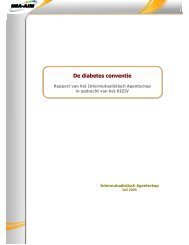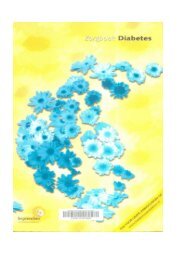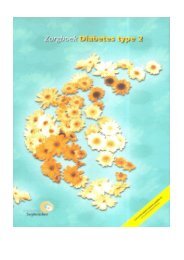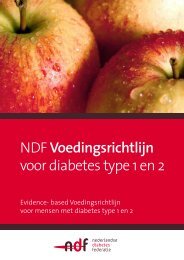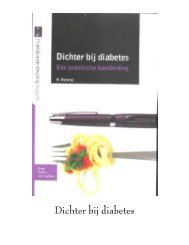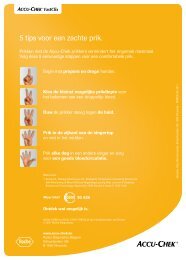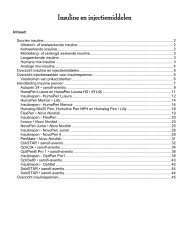Ideal Injection Techniques When Using 5-mm Needles in ... - Bvvde
Ideal Injection Techniques When Using 5-mm Needles in ... - Bvvde
Ideal Injection Techniques When Using 5-mm Needles in ... - Bvvde
You also want an ePaper? Increase the reach of your titles
YUMPU automatically turns print PDFs into web optimized ePapers that Google loves.
<strong>Ideal</strong> <strong>Injection</strong> <strong>Techniques</strong> <strong>When</strong> <strong>Us<strong>in</strong>g</strong> 5-<strong>mm</strong> <strong>Needles</strong> <strong>in</strong><br />
Children and Adults<br />
Paul Leslie Hofman, MD, 1 José Guilherme Behrensdorf Derraik, PHD, 1 Teresa Elizabeth P<strong>in</strong>to, MD, 1 Sheryl Tregurtha,<br />
BNURS, 2 Ann Faherty, MHSC, 2 Jane Michele Peart, MD, 2 Paul Leslie Drury, MD, 2 Elizabeth Rob<strong>in</strong>son, MSC, 3 Ram<strong>in</strong><br />
Tehranchi, MD, PHD, 4 Morten Donsmark, PHD, 4 and Wayne Stephen Cutfield, MD 1<br />
1 Ligg<strong>in</strong>s Institute, University of Auckland, Auckland, New Zealand; 2 Auckland Diabetes Centre, Auckland District Health<br />
Board, Auckland, New Zealand; 3 Department of Epidemiology and Biostatistics, University of Auckland, Auckland, New<br />
Zealand; and 4 Novo Nordisk A/S, Copenhagen, Denmark.<br />
Abstract<br />
Objective - We aimed to establish the ideal <strong>in</strong>jection techniques us<strong>in</strong>g 5-<strong>mm</strong> needles to reliably<br />
<strong>in</strong>ject <strong>in</strong>sul<strong>in</strong> <strong>in</strong>to the subcutaneous fat <strong>in</strong> both children and adults and to quantify the associated<br />
pa<strong>in</strong> and leakage of the test medium.<br />
Research design and methods - A total of 259 subjects (122 children/adolescents and 137<br />
adults) were <strong>in</strong>jected with sterile air correspond<strong>in</strong>g to 20 IU <strong>in</strong>sul<strong>in</strong> (200 μl) with 32-G 5-<strong>mm</strong><br />
needles at 90° or 45°, <strong>in</strong> the abdomen and thigh, and with or without a p<strong>in</strong>ched sk<strong>in</strong> fold. <strong>Injection</strong><br />
depth was assessed via ultrasonography. Subjects rated pa<strong>in</strong> on a visual analog scale. Test<br />
medium <strong>in</strong>jections <strong>in</strong>to the abdomen and thigh (0.2–0.6 ml) were also adm<strong>in</strong>istered to assess<br />
<strong>in</strong>jection leakage.<br />
Results - Among children, 5.5% of <strong>in</strong>jections were <strong>in</strong>tramuscular (IM) and 0.5% were <strong>in</strong>tradermal,<br />
while <strong>in</strong> adults, the <strong>in</strong>cidence was 1.3 and 0.6%, respectively. The frequency of IM <strong>in</strong>jections was<br />
greater <strong>in</strong> boys and negligible among adult women. Subcutaneous fat thickness was the primary<br />
predictor of the likelihood of IM <strong>in</strong>jections (P < 0.001). A third of all patients reported experienc<strong>in</strong>g<br />
no pa<strong>in</strong> dur<strong>in</strong>g <strong>in</strong>sul<strong>in</strong> <strong>in</strong>jection, with children/adolescents experienc<strong>in</strong>g considerably more<br />
discomfort than adults. Some leakage of medium was observed, but was unrelated to <strong>in</strong>jection<br />
volume and was generally m<strong>in</strong>imal.<br />
Conclusions - 5-<strong>mm</strong> needles are reliably <strong>in</strong>serted <strong>in</strong>to subcutaneous fat <strong>in</strong> both adults and<br />
children. These needles were associated with reduced pa<strong>in</strong> and m<strong>in</strong>imal leakage. We reco<strong>mm</strong>end<br />
an angled <strong>in</strong>jection with a p<strong>in</strong>ched sk<strong>in</strong> fold for children, while <strong>in</strong> adults, the technique should be left<br />
to patient preference.<br />
Introduction<br />
Although there are many new technologies assist<strong>in</strong>g <strong>in</strong> diabetes care, multiple daily <strong>in</strong>jections<br />
rema<strong>in</strong> the ma<strong>in</strong>stay of therapy where <strong>in</strong>sul<strong>in</strong> is required. Such <strong>in</strong>jections aim to reliably deposit<br />
<strong>in</strong>sul<strong>in</strong> <strong>in</strong>to subcutaneous fat while m<strong>in</strong>imiz<strong>in</strong>g <strong>in</strong>advertent <strong>in</strong>tramuscular (IM) <strong>in</strong>jections. [1]<br />
Intramuscular <strong>in</strong>jections of regular, NPH, and glarg<strong>in</strong>e <strong>in</strong>sul<strong>in</strong> have been associated with variability<br />
<strong>in</strong> glycemic control and an <strong>in</strong>creased risk of severe hypoglycemia. [2–6] Although no studies have<br />
systematically evaluated the frequency of IM <strong>in</strong>jections among diabetic patients, these appear to be<br />
relatively co<strong>mm</strong>on. [6,7]<br />
The risk of IM <strong>in</strong>sul<strong>in</strong> deposition is associated with a number of factors <strong>in</strong>clud<strong>in</strong>g younger age, male<br />
sex, lower BMI, <strong>in</strong>jection technique (angle of <strong>in</strong>sertion and a lifted or p<strong>in</strong>ched sk<strong>in</strong> fold), and needle<br />
length. [5,8–11] Furthermore, the th<strong>in</strong>ner a person's sk<strong>in</strong> or subcutaneous fat layer, the greater the
chances of an accidental IM <strong>in</strong>jection. [5] Little <strong>in</strong>formation is known about sk<strong>in</strong> thickness, although it<br />
appears to vary with age, obesity, and puberty. [1]<br />
Not surpris<strong>in</strong>gly, needle length has been shown to be an important variable determ<strong>in</strong><strong>in</strong>g site of<br />
<strong>in</strong>sul<strong>in</strong> deposition. [5,12] However, although decreas<strong>in</strong>g the length of the <strong>in</strong>sul<strong>in</strong> needle reduces the<br />
<strong>in</strong>cidence of IM <strong>in</strong>jections, the use of 5-<strong>mm</strong> needles may result <strong>in</strong> <strong>in</strong>sul<strong>in</strong> be<strong>in</strong>g adm<strong>in</strong>istered too<br />
superficially <strong>in</strong> the dermal layer. [13,14] The consequence of <strong>in</strong>tradermal <strong>in</strong>sul<strong>in</strong> deposition is largely<br />
unknown, but may lead to <strong>in</strong>creased i<strong>mm</strong>une response, <strong>in</strong>jection pa<strong>in</strong>, and <strong>in</strong>sul<strong>in</strong> leakage. [14]<br />
Despite this, there have been few studies exam<strong>in</strong><strong>in</strong>g <strong>in</strong>jection technique. Perpendicular <strong>in</strong>sertion of<br />
6-, 8- and 12.7-<strong>mm</strong> needles has been associated with frequent IM <strong>in</strong>jections <strong>in</strong> children and<br />
adolescents with rates of 42, 38, and 86%, respectively. [1,5,8] By us<strong>in</strong>g an angled <strong>in</strong>sertion of 6-<strong>mm</strong><br />
needles, the risk of IM <strong>in</strong>jections was markedly reduced. [1] More recently, 4-<strong>mm</strong> needles <strong>in</strong>serted<br />
vertically were shown to be safe and effective <strong>in</strong> the majority of lean children and adults. [12]<br />
However, no evidence-based reco<strong>mm</strong>endations exist for 5-<strong>mm</strong> needles, which are be<strong>in</strong>g used with<br />
<strong>in</strong>creas<strong>in</strong>g frequency. Although there are some data on children with other needle lengths, [1,5,8] little<br />
<strong>in</strong>formation is available on adults, and it rema<strong>in</strong>s unclear how suitable shorter needles are for this<br />
group, especially for the obese.<br />
Our primary aim was to establish the ideal <strong>in</strong>jection techniques required to reliably <strong>in</strong>ject <strong>in</strong>sul<strong>in</strong> <strong>in</strong>to<br />
the subcutaneous fat <strong>in</strong> both children and adults us<strong>in</strong>g 5-<strong>mm</strong> needles. We also aimed to assess the<br />
level of discomfort associated with each technique and quantify the respective amounts of backflow<br />
or leakage of test medium to the sk<strong>in</strong> surface.<br />
Research Design and Methods<br />
Otherwise healthy children and adolescents with type 1 diabetes aged 5-19 years were recruited from<br />
the diabetes cl<strong>in</strong>ics at Starship Children's Hospital, Auckland, New Zealand. Adults with type 1 and type<br />
2 diabetes aged between 20 and 85 years were also recruited. Exclusion criteria <strong>in</strong>cluded moderate-tosevere<br />
lipohypertrophy, other medical conditions such as celiac disease or autoi<strong>mm</strong>une thyroid disease,<br />
associated syndromes (e.g., Down's syndrome), and other secondary causes of diabetes (e.g., cystic<br />
fibrosis). Lipohypertrophy was assessed cl<strong>in</strong>ically, and, <strong>in</strong> those subjects who demonstrated mild<br />
lipohypertrophy, no <strong>in</strong>jections were made <strong>in</strong>to areas where any adipose thicken<strong>in</strong>g was noted. Young<br />
subjects had weight and height measured and pubertal status recorded by a pediatric endocr<strong>in</strong>ologist<br />
(P.L.H. or T.E.P.).<br />
All subjects were <strong>in</strong>jected with sterile air correspond<strong>in</strong>g to 20 IU <strong>in</strong>sul<strong>in</strong> (200 μl) with NovoF<strong>in</strong>e 32-<br />
G 5-<strong>mm</strong> needles (Novo Nordisk, Copenhagen, Denmark) us<strong>in</strong>g NovoPen 4 pens (Novo Nordisk).<br />
Eight <strong>in</strong>jections were adm<strong>in</strong>istered either perpendicularly or at 45°, <strong>in</strong> the abdomen and thigh, and<br />
with or without a p<strong>in</strong>ched sk<strong>in</strong> fold. I<strong>mm</strong>ediately after each <strong>in</strong>jection, an assessment of the depth<br />
was made by a radiologist (J.M.P.) via ultrasonography us<strong>in</strong>g a Phillips IU-22 ultrasound mach<strong>in</strong>e<br />
and a 17.0-MHz l<strong>in</strong>ear array transducer. [1] The ultrasound site of the <strong>in</strong>jected air was assessed as<br />
<strong>in</strong>tradermal, subcutaneous fat, or IM. In addition, after each <strong>in</strong>jection, subjects were asked to rate<br />
the <strong>in</strong>jection pa<strong>in</strong> on a facial and visual analog scale, [15] with pa<strong>in</strong> response measured <strong>in</strong> millimeters.<br />
Subjects were also <strong>in</strong>jected with test medium (<strong>in</strong>sul<strong>in</strong>-free diluent) us<strong>in</strong>g FlexPen (Novo Nordisk<br />
A/S). <strong>Injection</strong> volumes of 200, 400, and 600 μl were tested (equivalent to 20, 40, and 60 units of<br />
<strong>in</strong>sul<strong>in</strong>). <strong>Us<strong>in</strong>g</strong> known unit doses of the diluents, milligram doses were converted to units (slope: 0.1<br />
mg = 10 μl; r = 0.98). Four <strong>in</strong>jections were made us<strong>in</strong>g either a perpendicular or angled <strong>in</strong>sertion<br />
and with a p<strong>in</strong>ched sk<strong>in</strong> fold <strong>in</strong>to either the abdomen or lateral thigh. All <strong>in</strong>jections were given by<br />
two experienced diabetes nurse specialists while the patient was sup<strong>in</strong>e, and the needle was
withdrawn after a slow count to six. After 20–30 s, the area was gently wiped with tissue paper and<br />
weighed us<strong>in</strong>g scientific scales (accurate to 10 μg).<br />
Ethical approval was received from the Auckland Ethics Co<strong>mm</strong>ittee, and <strong>in</strong>formed written consent<br />
was obta<strong>in</strong>ed from all parents and older subjects. In younger subjects, oral consent was also<br />
obta<strong>in</strong>ed.<br />
General l<strong>in</strong>ear regression models were used to compare the demographic characteristics of the<br />
subjects between sex, us<strong>in</strong>g age as a covariate. Generalized l<strong>in</strong>ear mixed models were used to<br />
<strong>in</strong>vestigate the associations between the outcomes from the <strong>in</strong>jections and the site (thigh or<br />
abdomen), angle (45° or 90°), and p<strong>in</strong>ch<strong>in</strong>g (unp<strong>in</strong>ched or p<strong>in</strong>ched). The person was treated as a<br />
random effect to allow for the correlations between measurements on the same subject. Factors<br />
<strong>in</strong>clud<strong>in</strong>g age, sex, BMI standard deviation score (BMI SDS), sk<strong>in</strong> thickness, subcutaneous fat<br />
thickness, and pubertal status (for children) were <strong>in</strong>cluded <strong>in</strong> the models where appropriate. A logit<br />
l<strong>in</strong>k was used for b<strong>in</strong>ary outcomes namely: IM <strong>in</strong>jection (yes/no), leakage (yes/no), and pa<strong>in</strong><br />
(yes/no). The level of pa<strong>in</strong> was only <strong>in</strong>vestigated with<strong>in</strong> the group who had pa<strong>in</strong>. Percentages and<br />
means are presented to give an estimate of effect magnitude.<br />
Results<br />
There were 259 subjects <strong>in</strong>cluded <strong>in</strong> this study, <strong>in</strong>clud<strong>in</strong>g 122 children/adolescents and 137 adults<br />
(Table 1). The detailed demographic data are shown <strong>in</strong> Table 1. Sk<strong>in</strong> thickness varied m<strong>in</strong>imally<br />
with sex and age, although thigh sk<strong>in</strong> thickness <strong>in</strong> adult males was 10% greater than <strong>in</strong> females (P<br />
< 0.05, Table 1). The mean BMI steadily <strong>in</strong>creased with age <strong>in</strong> both males and females, and<br />
consequently the same pattern was observed for subcutaneous fat. Abdom<strong>in</strong>al subcutaneous fat<br />
thickness was not significantly different between prepubertal boys and girls, but it was 42% (P <<br />
0.01) and 30% (P < 0.01) greater <strong>in</strong> female than <strong>in</strong> male adolescents and adults, respectively. This<br />
sex difference was particularly pronounced <strong>in</strong> thigh subcutaneous fat, which was thicker <strong>in</strong> females<br />
than males by 49% before puberty (P < 0.05), 73% <strong>in</strong> adolescence (P < 0.001), and 95% <strong>in</strong><br />
adulthood (P < 0.001) (Table 1).<br />
Table 1. Demographics of the studied population<br />
Children Adolescents Adults<br />
Girls Boys Girls Boys Women Men<br />
n 17 (44) 22 (56) 39 (47) 44 (53) 78 (57) 59 (43)<br />
Age (years) 8.6 ± 1.2 8.6 ± 1.3 14.1 ± 2.7 14.0 ± 2.0 45.4 ± 13.9 44.3 ± 13.9<br />
BMI — — — — 28.5 ± 7.0 27.3 ± 5.2<br />
BMI SDS 0.79 ± 1.16 0.52 ± 1.02 1.0 ± 1.1 1.1 ± 1.0 — —<br />
BMI >85% or >27 kg/m 2 * 5 (29) 6 (27) 15 (38) 23 (53) 40 (51) 26 (44)<br />
BMI >95% or >30 kg/m 2 * 3 (18) 3 (14) 8 (20) 14 (33) 32 (41) 13 (22) †<br />
Abdom<strong>in</strong>al sk<strong>in</strong> thickness (<strong>mm</strong>) 1.5 ± 0.3 1.5 ± 0.4 2.0 ± 0.4 2.1 ± 0.7 2.0 ± 0.5 2.1 ± 0.4<br />
Abdom<strong>in</strong>al subcutaneous fat (<strong>mm</strong>) 8.9 ± 5.0 7.6 ± 4.1 15.5 ± 9.4 10.9 ± 6.2 ‡<br />
21.9 ± 11.2 16.9 ± 9.1 ‡<br />
Thigh sk<strong>in</strong> thickness (<strong>mm</strong>) 1.3 ± 0.5 1.3 ± 0.3 1.7 ± 0.4 1.7 ± 0.4 1.7 ± 0.6 1.9 ± 0.4 †<br />
Thigh subcutaneous fat (<strong>mm</strong>) 11.0 ± 6.7 7.4 ± 3.7 †<br />
14.0 ± 7.3 8.1 ± 3.1 §<br />
18.1 ± 9.5 9.3 ± 3.9 §<br />
Data are n (%) or means ± SD. *BMI >85% and >95% centiles apply to children, whereas BMI >27 kg/m 2 and >30<br />
kg/m 2 refer to adults.<br />
A total of 2,072 <strong>in</strong>jections were adm<strong>in</strong>istered: 976 to children/adolescents and 1,096 to adults<br />
(Table 2). Among children, relatively few <strong>in</strong>jections were <strong>in</strong>serted outside subcutaneous fat<br />
irrespective of the site and technique used for adm<strong>in</strong>istration, with 54 IM (5.5%) and 5 <strong>in</strong>tradermal<br />
(0.5%) <strong>in</strong>jections recorded. The <strong>in</strong>cidence of IM <strong>in</strong>jections among adults was even lower, and 14 IM<br />
(1.3%) and 7 <strong>in</strong>tradermal (0.6%) adm<strong>in</strong>istrations were recorded (Table 2).
Table 2. Frequency of <strong>in</strong>tradermal, subcutaneous fat, and IM <strong>in</strong>jections <strong>in</strong> children (n = 976)<br />
and adults (n = 1,096) accord<strong>in</strong>g to the various <strong>in</strong>jection techniques<br />
Children/adolescents Adults<br />
Technique<br />
Unp<strong>in</strong>ched<br />
Abdom<strong>in</strong>al<br />
Intradermal Subcutaneous fat IM Intradermal Subcutaneous fat IM<br />
45° 0 113 (92.6) 9 (7.4) 1 (1) 135 (98.5) 1 (0.7)<br />
Vertical<br />
Thigh<br />
1 (1) 111 (91.0) 10 (8.2) 1 (1) 134 (97.8) 2 (1.5)<br />
45° 1 (1) 119 (97.5) 2 (1.6) 0 136 (99.3) 1 (0.7)<br />
Vertical<br />
P<strong>in</strong>ched<br />
Abdom<strong>in</strong>al<br />
0 110 (90.2) 12 (9.8) 0 131 (95.6) 6 (4.4)<br />
45° 1 (1) 111 (91.0) 10 (8.2) 1 (1) 136 (99.3) 0<br />
Vertical<br />
Thigh<br />
1 (1) 115 (94.3) 6 (4.9) 2 (1) 135 (98.5) 0<br />
45° 0 119 (97.5) 3 (2.5) 2 (1) 134 (97.8) 1 (0.7)<br />
Vertical 1 (1) 119 (97.5) 2 (1.6) 0 134 (97.8) 3 (2.2)<br />
Total 5 (0.5) 917 (94.0) 54 (5.5) 7 (0.6) 1,075 (98.1) 14 (1.3)<br />
Data are n (%).<br />
Note that there were no adverse side effects associated with the <strong>in</strong>jections adm<strong>in</strong>istered to the<br />
subject. In particular, no bleed<strong>in</strong>g or bruis<strong>in</strong>g was observed.<br />
Intramuscular <strong>Injection</strong>s<br />
There was a significant association between age and the likelihood of an IM <strong>in</strong>jection (P < 0.01), which<br />
was much less frequent among adults (Table 2). Despite the relatively small number of IM <strong>in</strong>jections,<br />
analyses showed clear sex differences <strong>in</strong> the <strong>in</strong>cidence of IM <strong>in</strong>jections among children and adolescents<br />
(Table 3). In prepubertal boys, site made no difference, but angled and p<strong>in</strong>ched <strong>in</strong>jection appeared to<br />
reduce IM <strong>in</strong>cidence (Table 3). Among girls, no IM deposition was recorded when the sk<strong>in</strong> was p<strong>in</strong>ched<br />
or the <strong>in</strong>jection was applied to the thigh. Among adolescents, <strong>in</strong>jection technique did not affect the<br />
frequency of IM adm<strong>in</strong>istration, and no IM <strong>in</strong>jections were recorded dur<strong>in</strong>g thigh <strong>in</strong>jections <strong>in</strong> females.<br />
Such sex differences were more marked among adults, and the <strong>in</strong>cidence of IM <strong>in</strong>jections among<br />
women was negligible. In the abdomen, p<strong>in</strong>ched angled <strong>in</strong>jections are also likely to decrease the<br />
likelihood of an IM <strong>in</strong>jection occurr<strong>in</strong>g (Table 3). Subcutaneous fat thickness was the primary predictor of<br />
the likelihood of IM <strong>in</strong>jections (P < 0.001) and likely accounted for the sex differences (Table 1).<br />
Table 3. Frequency of IM <strong>in</strong>jections accord<strong>in</strong>g to sex and pubertal status<br />
Children Adolescents Adults<br />
Girls Boys Girls Boys Females Males<br />
Total <strong>in</strong>jections 136 176 312 352 624 472<br />
IM <strong>in</strong>jections 5 (3.6) 16 (9.1) 8 (2.6) 25 (7.1) 1 (0.2) 13 (2.8)<br />
Site<br />
Abdomen 5 (7.4) 8 (9.1) 8 (5.1) 14 (8.0) 1 (0.3) 2 (0.8)<br />
Thigh 0 8 (9.1) 0 11 (6.3) 0 11 (4.7)<br />
Angle<br />
45° 2 (2.9) 5 (5.6) 5 (3.2) 12 (6.8) 0 3 (1.3)<br />
Vertical 3 (4.4) 11 (12.5) 3 (1.9) 13 (7.4) 1 (0.3) 10 (4.2)<br />
Technique<br />
Unp<strong>in</strong>ched 5 (7.4) 10 (11.4) 4 (2.6) 14 (8.0) 1 (0.3) 9 (3.8)<br />
P<strong>in</strong>ched 0 6 (6.8) 4 (2.6) 11 (6.3) 0 4 (1.7)<br />
Data are N or n (%).
Pa<strong>in</strong><br />
Approximately one-third of all patients reported experienc<strong>in</strong>g no pa<strong>in</strong> dur<strong>in</strong>g <strong>in</strong>sul<strong>in</strong> <strong>in</strong>jection (32%<br />
children and 31% adults). The angle or site of <strong>in</strong>jection had no bear<strong>in</strong>g on whether the subject<br />
experienced pa<strong>in</strong> or not. Among subjects who experienced pa<strong>in</strong>, children/adolescents experienced<br />
considerably more discomfort than adults (20.9 ± 0.8 vs. 14.1 ± 0.7 <strong>mm</strong>, respectively; P < 0.001).<br />
In addition, abdom<strong>in</strong>al <strong>in</strong>jections were less pa<strong>in</strong>ful than those applied to the thigh (16.2 ± 0.6 vs.<br />
18.8 ± 0.6 <strong>mm</strong>, respectively; P < 0.001).<br />
Leakage<br />
<strong>Injection</strong>s <strong>in</strong> adults were more likely to lead to leakage than those given to younger subjects (70%<br />
with detectable leakage among adults vs. 56% among children/adolescents, P < 0.01). The volume<br />
of medium given (200, 400, or 600 μl) did not affect the likelihood of leakage occurr<strong>in</strong>g (P = 0.41).<br />
However, leakage was more likely to occur with vertical <strong>in</strong>jections (65% for vertical and 59% for<br />
angled, P < 0.001) and with thigh <strong>in</strong>jections (66% to thigh and 58% to abdomen, P < 0.001).<br />
Nonetheless, the amount of leakage recorded <strong>in</strong> each case was generally m<strong>in</strong>imal, amount<strong>in</strong>g to<br />
the equivalent of a fraction of a unit (Table 4).<br />
Table 4. Amount of leakage associated with <strong>in</strong>jections of <strong>in</strong>sul<strong>in</strong> medium<br />
<strong>Injection</strong> technique<br />
Abdom<strong>in</strong>al<br />
200<br />
<strong>Injection</strong> volume (μl)<br />
400 600<br />
Angled 2 ± 3 2 ± 6 2 ± 3<br />
Vertical<br />
Thigh<br />
2 ± 3 1 ± 7 3 ± 5<br />
Angled 4 ± 8 3 ± 7 5 ± 7<br />
Vertical 7 ± 12 11 ± 18 6 ± 11<br />
Data are means ± SD. 10 μl is an equivalent volume to 1 unit of <strong>in</strong>sul<strong>in</strong>. All <strong>in</strong>jections were applied with p<strong>in</strong>ched sk<strong>in</strong>.<br />
Conclusions<br />
This study demonstrated that 32-G 5-<strong>mm</strong> needles can be reliably <strong>in</strong>serted <strong>in</strong>to subcutaneous fat,<br />
are relatively pa<strong>in</strong> free, and are associated with m<strong>in</strong>imal leakage from the <strong>in</strong>jection site. Previous<br />
studies us<strong>in</strong>g 6-, 8-, and 12.7-<strong>mm</strong> needles have demonstrated that <strong>in</strong>jection technique is important<br />
<strong>in</strong> determ<strong>in</strong><strong>in</strong>g <strong>in</strong>jection depth. [1,5,8] These data <strong>in</strong>dicated that, <strong>in</strong> children, 8-<strong>mm</strong> needles have an<br />
unacceptable rate of IM <strong>in</strong>jections. Even 6-<strong>mm</strong> needles had a high rate of IM <strong>in</strong>jections when<br />
<strong>in</strong>serted vertically, although none were reported with an angled <strong>in</strong>sertion. [1] It was thus<br />
reco<strong>mm</strong>ended that 6-<strong>mm</strong> needles should be <strong>in</strong>serted at an angle <strong>in</strong> children and should be<br />
preferred to 8-<strong>mm</strong> needles <strong>in</strong> leaner children at higher risk of IM <strong>in</strong>jections.<br />
The current <strong>in</strong>vestigation exam<strong>in</strong>ed several different paradigms <strong>in</strong>volv<strong>in</strong>g needle <strong>in</strong>sertion with 5<strong>mm</strong><br />
needles. Although all paradigms used resulted <strong>in</strong> the majority of <strong>in</strong>jections correctly sited <strong>in</strong><br />
subcutaneous fat, it is of concern that some techniques led to 10% of <strong>in</strong>sul<strong>in</strong> <strong>in</strong>jections be<strong>in</strong>g<br />
<strong>in</strong>tramuscular <strong>in</strong> young subjects. There was an expected reduction <strong>in</strong> IM <strong>in</strong>jections us<strong>in</strong>g a p<strong>in</strong>ched<br />
sk<strong>in</strong> fold and angled <strong>in</strong>sertion <strong>in</strong> prepubertal children, and this comb<strong>in</strong>ation appears to result <strong>in</strong> the<br />
most reliable <strong>in</strong>sertion <strong>in</strong>to subcutaneous fat <strong>in</strong> children and lean adults. In adolescents and adults<br />
(especially women), unless they are particularly th<strong>in</strong>, any of the <strong>in</strong>jection paradigms used would be<br />
acceptable and the technique should be based on patient preference.
Discomfort and pa<strong>in</strong> were remarkably low <strong>in</strong> this study. We observed no significant difference <strong>in</strong><br />
pa<strong>in</strong> perception between 45° and 90° <strong>in</strong>jections, which is consistent with previous f<strong>in</strong>d<strong>in</strong>gs. [16]<br />
Needle pa<strong>in</strong> is directly related to needle diameter, and the study needle used is one of the th<strong>in</strong>nest<br />
co<strong>mm</strong>ercially available. While not directly comparable, a previous study us<strong>in</strong>g the same<br />
methodology resulted <strong>in</strong> significantly higher pa<strong>in</strong> scores for both 31-G 6-<strong>mm</strong> and 30-G 8-<strong>mm</strong><br />
needles <strong>in</strong>sertion, and it was our experience that the 32-G 5-<strong>mm</strong> needles were somewhat less<br />
pa<strong>in</strong>ful. [1] It is worth not<strong>in</strong>g that among <strong>in</strong>dividuals who experience discomfort, children had higher<br />
scores than adults. Needle aversion and phobia appear to be co<strong>mm</strong>on <strong>in</strong> children with diabetes, [17]<br />
and pa<strong>in</strong> associated with daily <strong>in</strong>jections is said to be important <strong>in</strong> discourag<strong>in</strong>g patients to adhere<br />
to treatment. [18] Thus, less pa<strong>in</strong>ful <strong>in</strong>jections would probably help with the acceptance and tolerability<br />
of <strong>in</strong>sul<strong>in</strong> therapy, potentially lead<strong>in</strong>g to <strong>in</strong>creased treatment compliance.<br />
Possible concerns regard<strong>in</strong>g smaller needles <strong>in</strong>clude greater <strong>in</strong>sul<strong>in</strong> leakage or back flow. This<br />
issue was assessed <strong>in</strong> a previous study of lean children and adults us<strong>in</strong>g 4-<strong>mm</strong> needles, and such<br />
problems were not observed. In our study and <strong>in</strong> doses up to 0.6 ml (equivalent to 60 units <strong>in</strong>sul<strong>in</strong>),<br />
we similarly demonstrated m<strong>in</strong>imal leakage. Although greater <strong>in</strong> the thigh and with perpendicular<br />
needle <strong>in</strong>sertion, leakage (when present) was usually very small. All <strong>in</strong>jections were adm<strong>in</strong>istered<br />
while the patient was sup<strong>in</strong>e and, although unlikely, it is nonetheless possible that more leakage<br />
would have occurred <strong>in</strong> a sitt<strong>in</strong>g position or with a flexed leg.<br />
In su<strong>mm</strong>ary, we have demonstrated <strong>in</strong> both adults and children that 5-<strong>mm</strong> needles can reliably be<br />
<strong>in</strong>serted <strong>in</strong>to subcutaneous fat. In children, our f<strong>in</strong>d<strong>in</strong>gs <strong>in</strong>dicate that an angled approach with a<br />
p<strong>in</strong>ched sk<strong>in</strong> fold should be used. In adults, the technique should be left to patient preference. The<br />
reduced <strong>in</strong>cidence of pa<strong>in</strong> observed with the use of these needles <strong>in</strong> comparison to previous<br />
studies may improve compliance issues, especially <strong>in</strong> children, although this will require further<br />
study. F<strong>in</strong>ally, there is evidence that no substantial back flow or leakage occurs from us<strong>in</strong>g shorter<br />
needles <strong>in</strong> doses up to 60 units.<br />
References<br />
1. Hofman PL, Lawton SA, Peart JM, Holt JA, Jefferies CA, Rob<strong>in</strong>son E, Cutfield WS. An angled <strong>in</strong>sertion technique us<strong>in</strong>g 6-<strong>mm</strong><br />
needles markedly reduces the risk of <strong>in</strong>tramuscular <strong>in</strong>jections <strong>in</strong> children and adolescents. Diabet Med 2007;24:1400–1405<br />
2. Frid A, Ostman J, L<strong>in</strong>de B. Hypoglycemia risk dur<strong>in</strong>g exercise after <strong>in</strong>tramuscular <strong>in</strong>jection of <strong>in</strong>sul<strong>in</strong> <strong>in</strong> thigh <strong>in</strong> IDDM. Diabetes<br />
Care 1990;13:473–477<br />
3. Thow J, Home P. Insul<strong>in</strong> <strong>in</strong>jection technique. Br Med J 1990;301:3–4<br />
4. Karges B, Boehm BO, Karges W. Early hypoglycaemia after accidental <strong>in</strong>tramuscular <strong>in</strong>jection of <strong>in</strong>sul<strong>in</strong> glarg<strong>in</strong>e. Diabet Med<br />
2005;22:1444–1445<br />
5. Tubiana-Rufi N, Belarbi N, Du Pasquier-Fediaevsky L, Polak M, Kakou B, Leridon L, Hassan M, Czernichow P. Short needles (8<br />
<strong>mm</strong>) reduce the risk of <strong>in</strong>tramuscular <strong>in</strong>jections <strong>in</strong> children with type 1 diabetes. Diabetes Care 1999;22:1621–1625<br />
6. Smith CP, Sargent MA, Wilson BP, Price DA. Subcutaneous or <strong>in</strong>tramuscular <strong>in</strong>sul<strong>in</strong> <strong>in</strong>jections. Arch Dis Child 1991;66:879–882<br />
7. Frid A, L<strong>in</strong>den B. Where do lean diabetics <strong>in</strong>ject their <strong>in</strong>sul<strong>in</strong>? A study us<strong>in</strong>g computed tomography. Br Med J 1986;292:1638<br />
8. Polak M, Beregszaszi M, Belarbi N, Benali K, Hassan M, Czernichow P, Tubiana-Rufi N. Subcutaneous or <strong>in</strong>tramuscular<br />
<strong>in</strong>jections of <strong>in</strong>sul<strong>in</strong> <strong>in</strong> children: are we <strong>in</strong>ject<strong>in</strong>g where we th<strong>in</strong>k we are? Diabetes Care 1996;19:1434–1436<br />
9. Bantle JP, Neal L, Frankamp LM. Effects of the anatomical region used for <strong>in</strong>sul<strong>in</strong> <strong>in</strong>jections on glycemia <strong>in</strong> type I diabetes<br />
subjects. Diabetes Care 1993;16:1592–1597<br />
10. Birkebaek NH, Johansen A, Solvig J. Cutis/subcutis thickness at <strong>in</strong>sul<strong>in</strong> <strong>in</strong>jection sites and localization of simulated <strong>in</strong>sul<strong>in</strong><br />
boluses <strong>in</strong> children with type 1 diabetes mellitus: need for <strong>in</strong>dividualization of <strong>in</strong>jection technique? Diabet Med 1998;15:965–971<br />
11. Frid A, L<strong>in</strong>de B. Cl<strong>in</strong>ically important differences <strong>in</strong> <strong>in</strong>sul<strong>in</strong> absorption from abdomen <strong>in</strong> IDDM. Diabetes Res Cl<strong>in</strong> Pract<br />
1993;21:137–141<br />
12. Birkebaek NH, Solvig J, Hansen B, Jorgensen C, Smedegaard J, Christiansen JS. A 4-<strong>mm</strong> needle reduces the risk of<br />
<strong>in</strong>tramuscular <strong>in</strong>jections without <strong>in</strong>creas<strong>in</strong>g backflow to sk<strong>in</strong> surface <strong>in</strong> lean diabetic children and adults. Diabetes Care<br />
2008;31:e65<br />
13. Strauss K. Insul<strong>in</strong> <strong>in</strong>jection techniques: report from the 1st International Insul<strong>in</strong> <strong>Injection</strong> Technique Workshop, Strasbourg,<br />
France, June 1997. Pract Diabetes Int 1998;15:181–184<br />
14. Strauss K, Hannet I, McGonigle J, Parkes J, G<strong>in</strong>sberg B, Jamal R, Frid A. Ultra-short (5 <strong>mm</strong>) <strong>in</strong>sul<strong>in</strong> needles: trial results and<br />
cl<strong>in</strong>ical reco<strong>mm</strong>endations. Pract Diabetes Int 1999;16:218–222
15. McGrath PA. Evaluat<strong>in</strong>g a child's pa<strong>in</strong>. J Pa<strong>in</strong> Symptom Manage 1989;4:198–214<br />
16. Egekvist H, Bjerr<strong>in</strong>g P, Arendt-Nielsen L. Pa<strong>in</strong> and mechanical <strong>in</strong>jury of human sk<strong>in</strong> follow<strong>in</strong>g needle <strong>in</strong>sertions. Eur J Pa<strong>in</strong><br />
1999;3:41–49<br />
17. Zamban<strong>in</strong>i A, Feher MD. Needle phobia <strong>in</strong> type 1 diabetes mellitus. Diabet Med 1997;14:321–323<br />
18. Ma<strong>in</strong> KM, Jørgensen JT, Hertel NT, Jensen S, Jakobsen L. Automatic needle <strong>in</strong>sertion dim<strong>in</strong>ishes pa<strong>in</strong> dur<strong>in</strong>g growth hormone<br />
<strong>in</strong>jection. Acta Paediatr 1995;84:331–334



